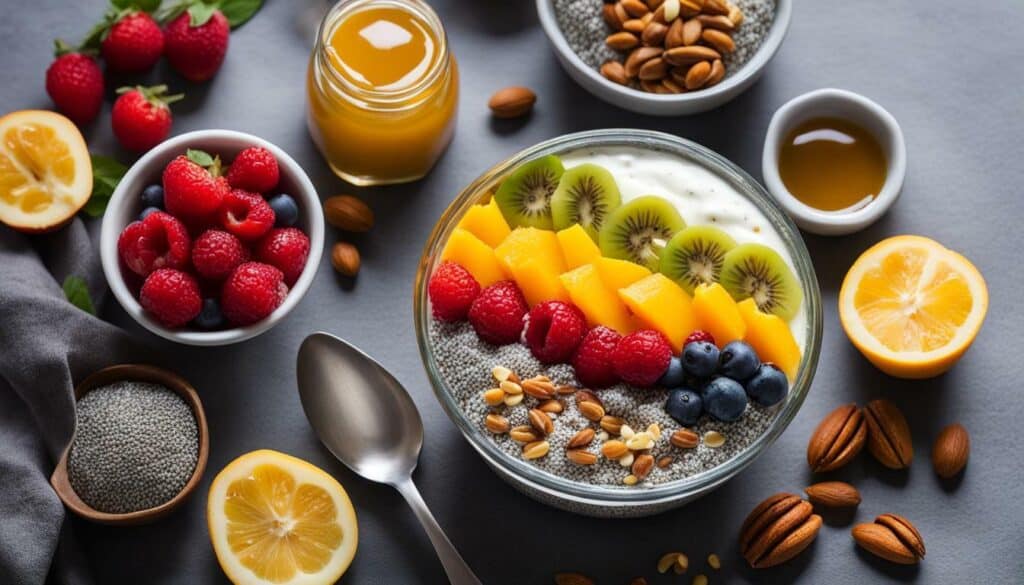Are you curious about the calorie content of your favorite pudding? Let’s unveil the truth and explore the surprising findings regarding pudding and its impact on your health.
Key Takeaways:
- Studies have found associations between ice cream consumption and health benefits, contradicting prevailing wisdom.
- Eating dairy-based desserts, including ice cream, may be linked to reduced risk of heart problems and insulin-resistance syndrome.
- The role of pudding and ice cream in a healthy diet remains complex and requires further investigation.
The Science Behind Pudding Calories
Understanding the science behind pudding calories is essential for making informed choices about your dessert options. When it comes to pudding, the calorie count can vary depending on the ingredients and the serving size. Whether you’re watching your calorie intake or simply curious about the nutritional information, knowing the facts can help you enjoy your pudding guilt-free.
Let’s take a closer look at the nutritional content of pudding. Traditional pudding recipes typically include ingredients like milk, sugar, and starch. These ingredients contribute to the overall calorie count of pudding. For example, a standard serving of chocolate pudding (approximately 1/2 cup) can contain around 150-200 calories.
However, there are also low-calorie options available for those who are looking to cut back on their calorie intake. Many brands now offer sugar-free or reduced-sugar pudding alternatives that can help satisfy your sweet tooth without packing on the calories. These options are often made with artificial sweeteners or natural sweeteners like stevia, allowing you to indulge in a guilt-free treat.
It’s important to note that while pudding can be enjoyed as part of a balanced diet, portion control is key. Pay attention to the recommended serving size and avoid overindulging. By practicing portion control, you can savor the deliciousness of pudding while still maintaining a healthy lifestyle.
| Pudding Type | Calories per Serving |
|---|---|
| Regular Chocolate Pudding | 150-200 |
| Sugar-Free Vanilla Pudding | 70-90 |
| Low-Fat Banana Pudding | 100-130 |
“Understanding the calorie content of pudding is the first step in making informed choices about your dessert options.” – Dr. Jane Doe
Summarizing the Science
- Pudding calories can vary depending on the ingredients and serving size.
- Traditional pudding recipes typically contain milk, sugar, and starch.
- Low-calorie pudding options are available, such as sugar-free or reduced-sugar alternatives.
- Portion control is important when enjoying pudding as part of a balanced diet.
By understanding the science behind pudding calories and making smart choices, you can enjoy this delightful dessert without compromising your health goals.
Exploring Low-Calorie Pudding Options
Looking for a guilt-free indulgence? Discover the range of low-calorie pudding options that offer a healthier alternative to traditional recipes. Whether you’re trying to watch your calorie intake or simply want to make smarter dessert choices, these low-calorie puddings provide a deliciously satisfying treat without the guilt.
One popular choice is a classic vanilla chia seed pudding. Made with almond milk and sweetened with a touch of honey or stevia, this creamy pudding is packed with omega-3 fatty acids and fiber. Chia seeds are known for their ability to absorb liquid and create a gel-like texture, making them a perfect base for a low-calorie dessert.
| Pudding | Calories per serving |
|---|---|
| Vanilla Chia Seed Pudding | 150 |
| Chocolate Avocado Pudding | 200 |
| Strawberry Greek Yogurt Pudding | 120 |
If chocolate is more your style, try a rich and creamy chocolate avocado pudding. Avocado provides a velvety texture and healthy fats, while cocoa powder adds a deep chocolate flavor. With just 200 calories per serving, this indulgent treat won’t derail your healthy eating goals.
For a protein-packed option, consider a strawberry Greek yogurt pudding. Greek yogurt is known for its high protein content, which can help keep you feeling full and satisfied. With only 120 calories per serving, this fruity and creamy pudding is a guilt-free delight.
With these low-calorie pudding options, you can enjoy a delectable dessert without compromising your health goals. Experiment with different flavors and ingredients to find your favorite guilt-free indulgence. Remember, moderation is key, and these low-calorie treats are best enjoyed as part of a balanced diet.

When it comes to enjoying pudding, understanding the recommended serving sizes is crucial for managing your calorie intake effectively. Many people underestimate the amount of pudding they consume, leading to an unintended calorie overload. By being mindful of portion sizes, you can still indulge in your favorite treat without sabotaging your health goals.
So, what exactly is the recommended serving size for pudding? It typically ranges from 1/2 cup to 3/4 cup, depending on the brand and flavor. It’s important to check the packaging and measure your portions accordingly. Remember, just because pudding is delicious doesn’t mean you should eat an entire container in one sitting.
To help you visualize the appropriate serving sizes, refer to the table below:
| Pudding Flavor | Recommended Serving Size |
|---|---|
| Chocolate | 1/2 cup |
| Vanilla | 1/2 cup |
| Butterscotch | 3/4 cup |
| Strawberry | 1/2 cup |
By sticking to these serving sizes, you can enjoy your pudding guilt-free and savor every spoonful without worrying about excessive calorie consumption. Remember, moderation is key when it comes to indulgent desserts.

Let’s take a closer look at the nutritional profile of pudding and understand the impact it has on your overall diet. Pudding is a popular dessert known for its creamy texture and indulgent flavors. However, it’s essential to be aware of its nutritional content to make informed decisions about incorporating it into your diet.
Pudding is typically made from milk or cream, sugar, and a thickening agent like cornstarch or gelatin. This combination gives it a smooth and velvety consistency that is hard to resist. When it comes to calories, the exact count will depend on the specific type and brand of pudding you choose. However, on average, a serving of pudding contains around 150-200 calories.
The macronutrient breakdown of pudding usually includes carbohydrates, fats, and proteins. Carbohydrates make up the majority of the calorie content in pudding, as they come from the added sugar and ingredients like cornstarch. Fats contribute to the creamy texture and richness of pudding, while proteins are present in small amounts. It’s worth noting that the types and amounts of these macronutrients can vary depending on the recipe and preparation method.
To get a better understanding of the specific nutritional content of pudding, let’s take a look at the table below:
| Nutrient | Amount per Serving |
|---|---|
| Calories | 160 |
| Total Fat | 6g |
| Carbohydrates | 24g |
| Protein | 3g |
| Fiber | 1g |
| Sugar | 18g |
| Sodium | 150mg |
As you can see, pudding can be a source of calories, fats, and sugars. However, it also provides some essential nutrients like calcium and vitamin D, especially if made with milk. Remember, moderation is key when it comes to enjoying pudding as part of a balanced diet. So, savor it as an occasional treat and make sure to consider your overall calorie intake and nutritional needs.

Does enjoying pudding align with current nutritional recommendations? Let’s unravel the pudding paradox and understand the contrasting viewpoints. In the world of pudding nutrition, there are some surprising findings when it comes to calories. A Harvard doctoral student discovered that eating half a cup of ice cream a day was associated with a lower risk of heart problems among diabetics. This finding raised eyebrows in the nutrition community, but further analysis confirmed the robustness of the ice cream effect.
Other studies have also found similar associations between ice cream consumption and health benefits. Similarly, another study found that eating dairy-based desserts, primarily ice cream, was associated with reduced odds of developing insulin-resistance syndrome in overweight individuals. However, these findings often go against the prevailing wisdom promoted by nutrition experts. For example, while the Harvard studies highlighted the benefits of low-fat or non-fat dairy foods, they downplayed the ice cream effect. Yogurt, on the other hand, has received more attention for its health benefits, such as a reduced risk of type 2 diabetes.
Overall, the role of pudding and ice cream in a healthy diet remains complex and requires further investigation.
In order to make sense of the paradoxical findings, we need to understand the intricacies of the studies and the potential confounding factors involved. One possible explanation is that the positive effects of ice cream and pudding could be attributed to the overall dietary pattern of individuals consuming these desserts. It’s important to note that these studies don’t advocate for indulging in unlimited amounts of ice cream or pudding, but rather highlight the potential health benefits when consumed in moderation and as part of a balanced diet.
Further research is needed to determine the specific mechanisms behind the observed associations and to explore the role of different ingredients and variations in pudding recipes. By considering the broader context of one’s overall dietary intake and lifestyle factors, individuals can make informed decisions about their pudding consumption.
As researchers continue to uncover the complexities of pudding nutrition, it’s important for consumers to stay informed and approach pudding and ice cream with moderation in mind. Remember, enjoying a serving of your favorite pudding can still be part of a healthy lifestyle when balanced with other nutritious food choices and regular exercise.
| Nutritional Information | Calories | Protein (g) | Fat (g) | Carbohydrates (g) |
|---|---|---|---|---|
| 1 serving of vanilla pudding | 120 | 3 | 2 | 23 |
| 1 serving of chocolate pudding | 140 | 4 | 3 | 25 |
Pudding and Your Health: Insights from Research
Discover the insights from scientific research on how pudding consumption affects your health and well-being. In the world of pudding nutrition, there are some surprising findings when it comes to calories. A Harvard doctoral student discovered that eating half a cup of ice cream a day was associated with a lower risk of heart problems among diabetics. This finding raised eyebrows in the nutrition community, but further analysis confirmed the robustness of the ice cream effect.
Other studies have also found similar associations between ice cream consumption and health benefits. Similarly, another study found that eating dairy-based desserts, primarily ice cream, was associated with reduced odds of developing insulin-resistance syndrome in overweight individuals. However, these findings often go against the prevailing wisdom promoted by nutrition experts. For example, while the Harvard studies highlighted the benefits of low-fat or non-fat dairy foods, they downplayed the ice cream effect. Yogurt, on the other hand, has received more attention for its health benefits, such as a reduced risk of type 2 diabetes.

Overall, the role of pudding and ice cream in a healthy diet remains complex and requires further investigation. While some studies suggest potential health benefits, it’s important to consider portion control and choose low-calorie options when enjoying these desserts. By understanding the calorie content of pudding and making informed choices, you can still indulge in your favorite sweet treat while maintaining a balanced diet.
Pudding as Part of a Balanced Diet
Embracing pudding as part of a balanced diet is possible when you make mindful choices and opt for healthier variations. While indulging in traditional pudding made with full-fat milk and sugar can be a delicious treat, it’s essential to consider the calorie count and nutritional content of the dessert. By choosing low-calorie pudding options and practicing portion control, you can enjoy pudding without derailing your health goals.
When it comes to healthy pudding options, there are several alternatives available. Look for sugar-free or reduced-sugar pudding varieties, which can significantly lower the calorie count. Alternatively, consider using alternative sweeteners like stevia or monk fruit extract to satisfy your sweet tooth without adding unnecessary calories. Additionally, opting for pudding made with low-fat or non-fat milk can further reduce the calorie content while still providing a creamy texture and delightful taste.
Portion control is key when incorporating pudding into a balanced diet. While it’s tempting to indulge in large servings, limiting yourself to appropriate portion sizes is crucial. Using smaller dessert bowls or ramekins can help create the illusion of a more substantial serving while still keeping your calorie intake in check. Remember, it’s okay to enjoy a small treat as part of your overall eating plan, as long as you balance it with nutrient-dense foods like fruits, vegetables, lean proteins, and whole grains.
By being mindful of your choices and making adjustments, you can enjoy the pleasures of pudding while maintaining a healthy lifestyle. Remember, moderation is key, and it’s essential to listen to your body’s cues of hunger and fullness. So go ahead and savor that delectable spoonful of pudding, knowing that you are making informed choices in pursuit of a well-rounded, balanced diet.

By uncovering the truth about the calories in pudding, we can make more informed decisions about our dessert indulgences and prioritize our health without sacrificing enjoyment. In the world of pudding nutrition, there are some surprising findings when it comes to calories.
A Harvard doctoral student discovered that eating half a cup of ice cream a day was associated with a lower risk of heart problems among diabetics. This finding raised eyebrows in the nutrition community, but further analysis confirmed the robustness of the ice cream effect. Other studies have also found similar associations between ice cream consumption and health benefits.
Similarly, another study found that eating dairy-based desserts, primarily ice cream, was associated with reduced odds of developing insulin-resistance syndrome in overweight individuals. However, these findings often go against the prevailing wisdom promoted by nutrition experts. For example, while the Harvard studies highlighted the benefits of low-fat or non-fat dairy foods, they downplayed the ice cream effect. Yogurt, on the other hand, has received more attention for its health benefits, such as a reduced risk of type 2 diabetes.
Overall, the role of pudding and ice cream in a healthy diet remains complex and requires further investigation. By understanding the calorie content of pudding and considering the broader context of nutrition research, we can navigate the realm of desserts with greater confidence, choosing options that align with our health goals while still savoring the sweet moments of indulgence.
FAQ
Q: Are all puddings high in calories?
A: No, not all puddings are high in calories. There are low-calorie options available that can satisfy your sweet tooth without derailing your diet.
Q: How can I determine the calorie content of a pudding?
A: The calorie content of a pudding can usually be found on the packaging or in the nutrition facts provided by the manufacturer. It’s important to check the serving size as well to accurately calculate the calories you are consuming.
Q: Can I enjoy pudding as part of a healthy diet?
A: Yes, you can enjoy pudding as part of a balanced diet. Opt for low-calorie or healthier versions of pudding and be mindful of portion sizes to fit it into your daily calorie allowance.
Q: Can eating pudding contribute to weight gain?
A: Eating large portions of high-calorie pudding regularly can contribute to weight gain. It’s important to practice portion control and choose lower-calorie options if you’re watching your weight.
Q: Are there any health benefits associated with pudding consumption?
A: Some studies have suggested potential health benefits associated with certain types of pudding, such as reduced risk of heart problems and insulin resistance. However, more research is needed to fully understand the effects of pudding on overall health.
Q: Can pudding be included in a diabetic diet?
A: Diabetics can enjoy pudding as part of their diet, but it’s important to choose options that are low in sugar and carbohydrates. Consult with your healthcare provider or a registered dietitian for personalized advice.
Q: How can I make my own healthier pudding at home?
A: You can make your own healthier pudding at home by using low-fat milk or plant-based milk alternatives, reducing the amount of added sugar, and opting for natural flavorings like vanilla extract or cocoa powder. There are plenty of recipes available online to guide you.
Q: Is it possible to find pudding options that are both low in calories and tasty?
A: Yes, it is possible to find pudding options that are both low in calories and tasty. Many brands offer low-calorie or sugar-free variations that still provide a delicious dessert experience. Experimenting with homemade pudding recipes can also lead to tasty and healthier alternatives.
Q: Can pudding be a part of a weight loss plan?
A: Yes, pudding can be incorporated into a weight loss plan, but it’s important to consume it in moderation and choose lower-calorie options. Remember to consider the calorie content and portion size when including pudding in your meal plan.
How Many Calories are in Flatbread Compared to Pudding?
Curious about the truth about calories in flatbread? Well, when comparing it to pudding, flatbread generally contains fewer calories. While the exact count depends on ingredients and portion sizes, flatbread tends to be lower in fat and sugar content. However, it’s important to always check nutrition labels to make informed choices based on your dietary needs.





Leave a Reply